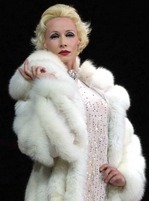SITE GUIDE
SEARCH
REVIEWS
REVIEW ARCHIVES
ADVERTISING AT CURTAINUP
FEATURES
NEWS
Etcetera and
Short Term Listings
LISTINGS
Broadway
Off-Broadway
NYC Restaurants
BOOKS and CDs
OTHER PLACES
Berkshires
London
California
New Jersey
DC
Philadelphia
Elsewhere
QUOTES
TKTS
PLAYWRIGHTS' ALBUMS
LETTERS TO EDITOR
FILM
LINKS
MISCELLANEOUS
Free Updates
Masthead
Writing for Us
A CurtainUp  London Review
London Review
 London Review
London ReviewDivas
|
That old black magic has me in its spell, that old black magic that you weave so well.
Those icy fingers up and down my spine That same old witchcraft when your eyes meet mine. — Lyrics to song sang by Judy Garland |

Zara Deakin as Dietrich
(Photo: michelwith.com) |
The show falls into three very separate acts with each act devoted to one singer. There is one principal dancer who recreates the spirit of each singer, so Caroline Petter is Edith Piaf but the ensemble will support, either with duets between a male dancer and a female dancer or with a whole line of Can Can dancers and top hatted escorts. There are originally choreographed moments and balletic leaps and girls cartwheeling. Schaufuss' dancers are all trained at ballet schools. The famous Piaf classic numbers are there: "Milord" which has a little show girl in fluffy white marabou (Theresa Cardoso) flirting with a tail coated toff with a Chaplin type cane; for "L'Hymne a l'amour" Yoko Takahashi, in a blue dress, dances against the Parisian skyline in a romantic pas de deux.
For the finale, it is Piaf's famous song "La Vie En Rose" and Caroline Petter dancing with sheer emotional expression, her only prop a straight backed silver Bauhaus chair which she uses to dance from behind so that initially we only see her legs and later her arms. Caroline, although she is much taller than the little sparrow, dances the roller coaster emotion of Piaf's extraordinary and often tortured life. Petter is tremendously athletic and her dance although very visual is also about pain as we watch the muscles of her back stretched out on the chair.
The second act, based on Marlene Dietrich, is the most colourful. It has backdrop of the Brandenburg Gate, of Dresden bombed in the war, the longing for Heimat or the homeland, jokey parades of camp Nazi soldiers, a GI for "Mein Blondes Baby", the death of Russians. Finally there's the evocative song about loss, "Sag mir, wo die Blumen sind" or "Where Have All the Flowers Gone." Peter Schaufuss' wife Zara Deakin is magnificent in her floor length white fur coat and lamé drop pink dress dancing her interpretation of the German singer with her hands outstretched, a shiver and then clutching her head in despair. There is great contrast in this act from the mickey taking of comic Nazi soldiers and girls in a similar uniform, but wearing shorts, to figures of death carrying off girls in flesh coloured body stockings on their backs, like the bodies from the camps, showing the agony of war and the Holocaust. Zara Deakin wears the ringmaster's red coat outfit for one number that we remember seeing Dietrich wear for "Kinder, heut' abend da such ich mir was aus". The original orchestrations are so rich for these Dietrich songs.
The third act see the Russian prima ballerina Irina Kolesnikova dance as Judy Garland always in red shoes evoking Dorothy and partnered by Stefan Wise. Kolesnikova with short dark hair wearing black and white with a red rose, is so excellent in her interpretation I could see Garland's daughter Lisa Minelli in some of her characterisation. All of the songs in this act are familiar, some wildly romantic, all evocative of Garland's own era when shows were shows. "Embraceable You" is gorgeously sentimental, "I've Got Rhythm" is exuberant, and "Friendship" which Garland sang with Johnny Mercer has a jaunty all male routine based on high balletic jumps. The backdrops are American, the recordings crystal clear and Kolesnikova's dancing perfection.
Peter Schaufuss' dance show is unlikely to please the ballet purists but there is surely a place in London's theatreland for this entertainment.
|
Divas
Choreography, Direction, Set, Costumes and Lighting Design by Peter Schaufuss Starring: Zara Deakin, Caroline Petter, Irina Kolesnikova With: Agnete Beierholm, Robin Bernadet, Theresa Cardoso, Nathan Driftmeyer, Sean Ganley, Adam Kirkham, Andrii Lytvynenko, James Muller, Megumi Oki, Luke Schaufuss, Maja StÝrseth, Tiffany Sztuk, Yoko Takahashi, Anna Thagesen, Quang Van, Josef Vasely, Katherine Watson, Benjamin Whitson, Stefan Wise, Simone Würtz Running time: Two hours 10 minutes with two intervals Box Office: 0844 412 4658 Booking to 5th July 2008 Reviewed by Lizzie Loveridge based on 19th June 2008 performance at Apollo Theatre, Shaftesbury Avenue, London W1 (Tube: Piccadilly Circus) |
|
REVIEW FEEDBACK Highlight one of the responses below and click "copy" or"CTRL+C"
Paste the highlighted text into the subject line (CTRL+ V): Feel free to add detailed comments in the body of the email and state if you'd like your comments published in our letters section. |
|
London Theatre Tickets Lion King Tickets Billy Elliot Tickets Mighty Boosh Tickets Mamma Mia Tickets We Will Rock You Tickets Theatre Tickets |




